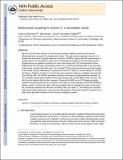Mechanical Coupling in Myosin V: A Simulation Study
Author(s)
Ovchinnikov, Victor; Trout, Bernhardt L.; Karplus, Martin
DownloadTrout_Mechanical coupling.pdf (5.723Mb)
OPEN_ACCESS_POLICY
Open Access Policy
Creative Commons Attribution-Noncommercial-Share Alike
Terms of use
Metadata
Show full item recordAbstract
Myosin motor function depends on the interaction between different domains that transmit information from one part of the molecule to another. The interdomain coupling in myosin V is studied with restrained targeted molecular dynamics using an all-atom representation in explicit solvent. To elucidate the origin of the conformational change due to the binding of ATP, targeting forces are applied to small sets of atoms (the forcing sets, FSs) in the direction of their displacement from the rigor conformation, which has a closed actin-binding cleft, to the post-rigor conformation, in which the cleft is open. The “minimal” FS that results in extensive structural changes in the overall myosin conformation is composed of ATP, switch 1, and the nearby HF, HG, and HH helices. Addition of switch 2 to the FS is required to achieve a complete opening of the actin-binding cleft. The restrained targeted molecular dynamics simulations reveal the mechanical coupling pathways between (i) the nucleotide-binding pocket (NBP) and the actin-binding cleft, (ii) the NBP and the converter, and (iii) the actin-binding cleft and the converter. Closing of the NBP due to ATP binding is tightly coupled to the opening of the cleft and leads to the rupture of a key hydrogen bond (F441N/A684O) between switch 2 and the SH1 helix. The actin-binding cleft may mediate the rupture of this bond via a connection between the HW helix, the relay helix, and switch 2. The findings are consistent with experimental studies and a recent normal mode analysis. The present method is expected to be useful more generally in studies of interdomain coupling in proteins.
Date issued
2009-10Department
Massachusetts Institute of Technology. Department of Chemical EngineeringJournal
Journal of Molecular Biology
Publisher
Elsevier B.V.
Citation
Ovchinnikov, Victor, Bernhardt L. Trout, and Martin Karplus. Mechanical Coupling in Myosin V: A Simulation Study. Journal of Molecular Biology 395, no. 4 (January 2010): 815-833.
Version: Author's final manuscript
ISSN
00222836
1089-8638